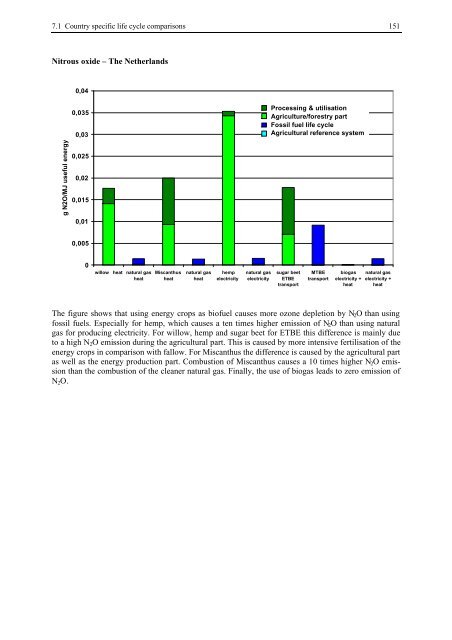BIOENERGY FOR EUROPE: WHICH ONES FIT BEST?
BIOENERGY FOR EUROPE: WHICH ONES FIT BEST?
BIOENERGY FOR EUROPE: WHICH ONES FIT BEST?
Create successful ePaper yourself
Turn your PDF publications into a flip-book with our unique Google optimized e-Paper software.
7.1 Country specific life cycle comparisons 151<br />
Nitrous oxide – The Netherlands<br />
g N2O/MJ useful energy<br />
0,04<br />
0,035<br />
0,03<br />
0,025<br />
0,02<br />
0,015<br />
0,01<br />
0,005<br />
0<br />
willow heat natural gas<br />
heat<br />
Miscanthus<br />
heat<br />
natural gas<br />
heat<br />
hemp<br />
electricity<br />
natural gas<br />
electricity<br />
Processing & utilisation<br />
Agriculture/forestry part<br />
Fossil fuel life cycle<br />
Agricultural reference system<br />
sugar beet<br />
ETBE<br />
transport<br />
MTBE<br />
transport<br />
biogas<br />
electricity +<br />
heat<br />
natural gas<br />
electricity +<br />
heat<br />
The figure shows that using energy crops as biofuel causes more ozone depletion by N2O than using<br />
fossil fuels. Especially for hemp, which causes a ten times higher emission of N2O than using natural<br />
gas for producing electricity. For willow, hemp and sugar beet for ETBE this difference is mainly due<br />
to a high N2O emission during the agricultural part. This is caused by more intensive fertilisation of the<br />
energy crops in comparison with fallow. For Miscanthus the difference is caused by the agricultural part<br />
as well as the energy production part. Combustion of Miscanthus causes a 10 times higher N2O emission<br />
than the combustion of the cleaner natural gas. Finally, the use of biogas leads to zero emission of<br />
N2O.

















